Environmental Engineering Reference
In-Depth Information
The reaction scheme is that of Miller and Bowman,
18
with 226 elementary
reactions occurring among 50 species. The governing equations for the flat flame
are the following:
∂
∂
ρ
∂
∂
()
=
+
ρ
u
0
(2.16)
t
x
∂
∂
T
t
∂
∂
T
x
=
∂
∂
∂
∂
T
x
+
∑
ρ
c
+
u
λ
φ
h
(2.17)
p
i
i
x
i
∂
∂
ωω
∂
∂
=
∂
∂
∂
∂
T
x
+
ρ
+
u
ρ
D
φ
i
=
1
…
n
(2.18)
i
t
x
x
ω
∑
i
p
=
ρ
T
m
(2.19)
i
i
where
x
is the position,
u
the flow velocity, λ the thermal conductivity,
w
i
the mass
fraction, φ
i
the production rate,
h
i
the enthalpy, and
m
i
the molecular weight of the
i
th species. The above equations are solved with the CHEMKIN package.
19,20
The dilution of the mixtures was simulated by assuming that combustion gases
in the ratio composition CO
2
: H
2
O : N
2
= 0.0948 : 0.1896 : 0.7156, the same as
that of the gases after a complete combustion of a methane/air mixture of equivalence
ratio = 1, are added to air. The dilution ratio, α, is expressed by the mole fraction
of O
2
in diluted air. When not specified all flames investigated here have an equiv-
alence ratio of unity.
2.3.2.2 Simulation Results and Discussion
2.3.2.2.1 Preheated but Not Diluted Premixed Flames
Figure 2.46
shows the variation of burning velocity with preheating temperature of
flames with α = 0.2095 (not diluted). It can be seen that the burning velocity increases
abruptly for preheating temperatures
T
0
higher than 1650 K. This is due to a change
in the flame propagation mechanism that occurs around that temperature, reported
previously.
21
Together with the burning velocity,
22
the ignition delay time of a well-stirred
mixture with the preheating temperature is also shown in the figure. The ignition
delay time is defined here as the interval between
t
= 0 and the time at which
dT
/
dt
becomes maximum. The ignition delay times for
T
0
= 1600 K and
T
0
= 1800 K, for
example, are 403 and 93.2 µs, respectively. In the flat flame, the time interval spent
by the gases before reaching the flame front derived from the flow velocity and the
distance from the burner to the flame front (defined as the position at which
dT
/
dx
is maximum) are 210 and 78 µs for
T
0
= 1600 and 1800 K, respectively. For
T
0
=
1800 K, the time interval in the flat flame is similar to the ignition delay time in the


Search WWH ::

Custom Search